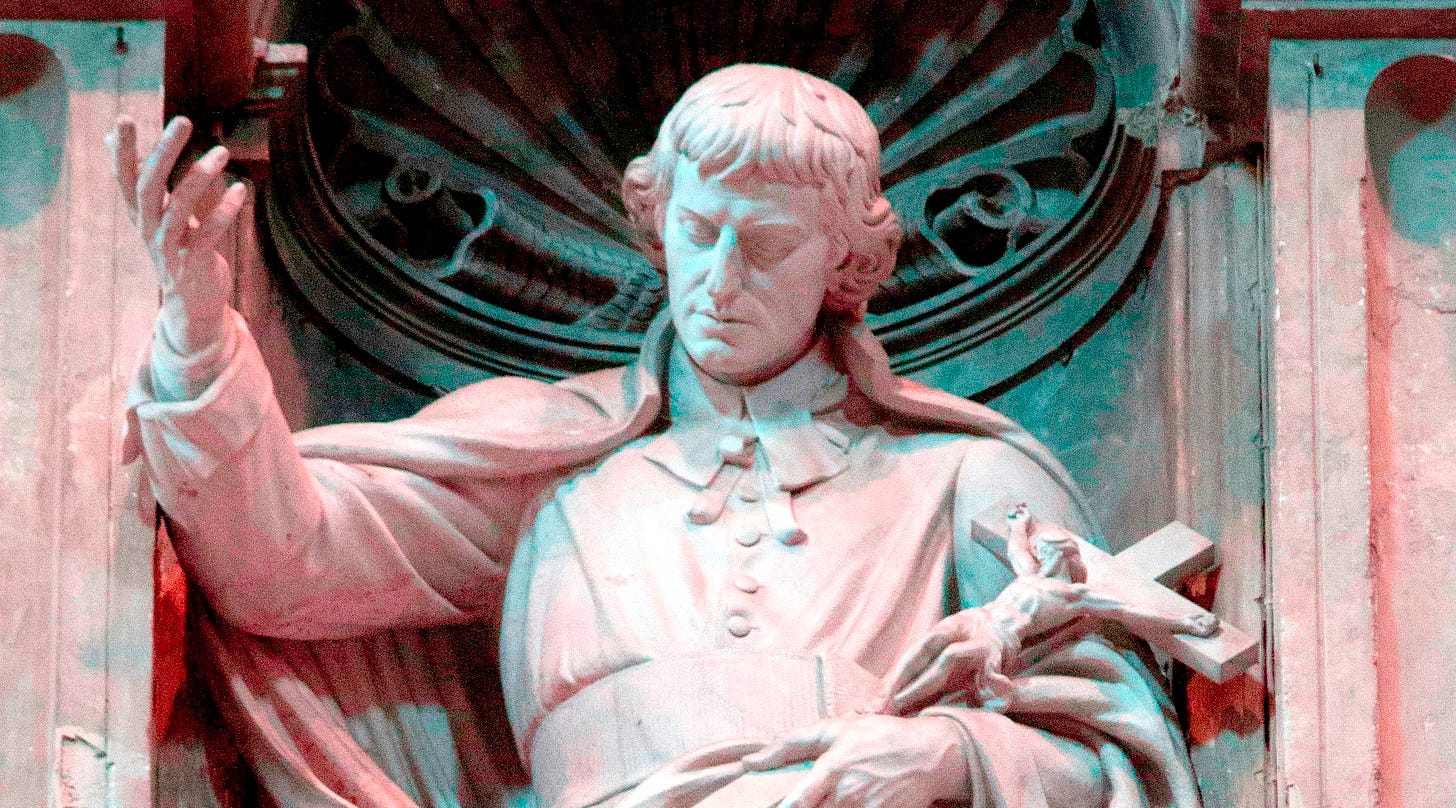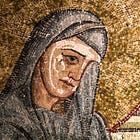Time to return to St Louis de Montfort? The WM Review's Advent Effort
In light of the attempted 'VatiCon' suppression of Our Lady's titles, The WM Review is announcing a major project for Advent: a communal preparation for St Louis de Montfort's consecration to Mary.

In light of the attempted ‘VatiCon’ suppression of Our Lady’s titles, The WM Review is announcing a major project for Advent: a communal preparation for St Louis de Montfort’s consecration to Mary.
Reparation is necessary
The practical response to blasphemy and insults against God and his saints is reparation.
Following the ‘VatiCon’ attempt to strip Our Lady of her august titles of Co-Redemptrix and Mediatrix of All Graces, many Catholics have manifested this instinctive response. We can inform readers that at least one chapel is commissioning a plaque for its Lady Altar, to serve as a perpetual reparation and profession of belief in these titles.
Our initial response was to publish a number of texts clarifying and explaining the doctrinal basis for the titles, and to profess our continued adherence to them.
We have also been astonished by the overwhelmingly positive reaction to our Co-Redemptrix and Mediatrix of All Graces mugs:
We suppose this is because they have given readers an opportunity to profess their adherence to these Marian titles in a physical way. But while profession of faith are important, reparation and spiritual exercises remain vital.
Having considered the options, we have decided to run a communal consecration to Our Lady on Christmas Eve, according to the method of St Louis de Montfort – preceded by a 33-day preparation which largely coincides with Advent.
The consecration will be to Our Lady under the title of her Immaculate Heart, as well as Co-Redemptrix and Mediatrix of All Graces.
We shall soon be publishing some further texts from Fr Réginald Garrigou-Lagrange which explain St Louis’ devotion.
We are presently assembling the texts for this communal preparation. St Louis himself stated that this preparation should be allowed to take various forms: we shall take his overarching themes as the template, and incorporate materials from other sources to those usually used (e.g., St Ignatius’ Spiritual Exercises, Fr Henry James Coleridge). It will also include fewer vocal prayers to say each day.
In the meantime, we encourage all readers who wish to join us to ensure they are signed up to at least the free email subscription…
… and to purchase a copy of the work and to read it as soon as possible.
We recommend the Baronius Press edition:
Baronius Press edition (Baronius Press)
Baronius Press edition (Amazon)
However, readers should beware.
In reading St Louis de Montfort’s book, and joining us in this Advent effort, they are engaging in what may now be considered as a subversive act.
True Devotion and the Forbidden Titles
In the late twentieth century and early twenty-first century, St Louis de Montfort’s True Devotion to the Blessed Virgin Mary was ubiquitous in conservative circles. Much of the anger at the removal of these titles is probably a fruit of his promotion of the de Montfort devotion.
St Louis’ method seems particularly fitting for this effort, given that the removal of the two titles – describing one as “always inappropriate” and “unhelpful,” and the other as conducive to error – is also an implicit censuring of St Louis de Montfort’s work. He affirms both doctrines throughout, and the devotion itself is based on the co-redemption and universal mediation of Our Lady.
For example, St Louis affirms Our Lady’s union, co-operation and subordinate co-offering of Christ’s sacrifice:
“Even at his death she had to be present so that he might be united with her in one sacrifice and be immolated with her consent to the eternal Father, just as formerly Isaac was offered in sacrifice by Abraham when he accepted the will of God. It was Mary who nursed him, fed him, cared for him, reared him, and sacrificed him for us.” (n. 18)
This is also the teaching of the Popes. St Louis’ reference to the Catholic conception of the Passion as a sacrifice of vicarious satisfaction offered to God – as opposed to the more Protestant idea of a mere penal substitution of the innocent for the guilty – might also explain one of the reasons why Protestants are so offended by the idea of Our Lady being called the “Co-Redemptrix.” One can unite one’s will to the offering of a sacrifice, and thus participate with it; it is harder to see how this would be the case in the erroneous system of many Protestants.
Elsewhere, St Louis provides a standard expression of Our Lady as the mediatrix and dispensatrix of all the graces which God wishes to give us:
“God the Father gathered all the waters together and called them the seas (maria). He gathered all his graces together and called them Mary (Maria). The great God has a treasury or storehouse full of riches in which he has enclosed all that is beautiful, resplendent, rare, and precious, even his own Son. This immense treasury is none other than Mary whom the saints call the “treasury of the Lord”. From her fullness all men are made rich.
“God the Son imparted to his mother all that he gained by his life and death, namely, his infinite merits and his eminent virtues. He made her the treasurer of all his Father had given him as heritage. Through her he applies his merits to his members and through her he transmits his virtues and distributes his graces. She is his mystical channel, his aqueduct, through which he causes his mercies to flow gently and abundantly.
“God the Holy Ghost entrusted his wondrous gifts to Mary, his faithful spouse, and chose her as the dispenser of all he possesses, so that she distributes all his gifts and graces to whom she wills, as much as she wills, how she wills and when she wills. No heavenly gift is given to men which does not pass through her virginal hands. Such indeed is the will of God, who has decreed that we should have all things through Mary, so that, making herself poor and lowly, and hiding herself in the depths of nothingness during her whole life, she might be enriched, exalted and honoured by almighty God. Such are the views of the Church and the early Fathers.” (nn. 23-5)
Nonetheless, St Louis is clear that Our Lady’s position is only what it is because God has willed it, and that she too is a creature:
“With the whole Church I acknowledge that Mary, being a mere creature fashioned by the hands of God is, compared to his infinite majesty, less than an atom, or rather is simply nothing, since he alone can say, “I am he who is”. Consequently, this great Lord, who is ever independent and self-sufficient, never had and does not now have any absolute need of the Blessed Virgin for the accomplishment of his will and the manifestation of his glory. To do all things he has only to will them.
“However, I declare that, considering things as they are, because God has decided to begin and accomplish his greatest works through the Blessed Virgin ever since he created her, we can safely believe that he will not change his plan in the time to come, for he is God and therefore does not change in his thoughts or his way of acting.” (nn. 14-15)
All this is anathema to the men who currently occupy the Vatican and purport to be the hierarchy of the Catholic Church. They have turned their aim not only at Our Lady and her titles, but even St Louis de Montfort and the grand edifice of Catholic theology.
This is why we said that this effort may be considered as a subversive act in our time. However, given that this purported hierarchy is in fact illegitimate and holds no authority whatsoever, this effort is not subversive but counter-revolutionary.
More: it is not just part of a counter-revolution against the religious revolution of the Conciliar/Synodal Church, but also the worldly liberalism that annually imposes itself upon us in the lead-up to Christmas.
Advent and True Devotion
Advent itself is a season under a unique assault in our time. There appears to be an almost universal conspiracy against the observation of a quiet and penitential period before Christmas – and the same applies against the celebration of Christmastide itself.
Our Lord made clear that, while we remain in the world, we are not to be of the world. It may be impossible for us to avoid the social expectations and logistical nightmare that is preparation for Christmas, but it is possible for us to try and keep our eyes focused on the true meaning of Christmas – which is the Gospel.
It also seems fitting to have this effort coincide with Advent, given St Louis’ focus on Christ in the womb of the Blessed Virgin. He writes:
“God the Son came into her virginal womb as a new Adam into his earthly paradise, to take his delight there and produce hidden wonders of grace.
“God-made-man found freedom in imprisoning himself in her womb. He displayed power in allowing himself to be borne by this young maiden. He found his glory and that of his Father in hiding his splendours from all creatures here below and revealing them only to Mary. He glorified his independence and his majesty in depending upon this lovable virgin in his conception, his birth, his presentation in the temple, and in the thirty years of his hidden life.” (n. 18)
Advent is also a time when we meditate on Christ being born within our souls – but how could we hope for such a grace without his Holy Mother? St Louis also talks of the elect being within the womb of Mary, as the body of which Christ is the head:
“As in the natural life a child must have a father and a mother, so in the supernatural life of grace a true child of the Church must have God for his Father and Mary for his mother. If he prides himself on having God for his Father but does not give to Mary the tender affection of a true child, he is an impostor and his father is the devil.
“Since Mary produced the head of the elect, Jesus Christ, she must also produce the members of that head, that is, all true Christians. A mother does not conceive a head without members, nor members without a head. If anyone, then, wishes to become a member of Jesus Christ, and consequently be filled with grace and truth, he must be formed in Mary through the grace of Jesus Christ, which she possesses with a fullness enabling her to communicate it abundantly to true members of Jesus Christ, her true children.
“The Holy Ghost espoused Mary and produced his greatest work, the incarnate Word, in her, by her and through her. He has never disowned her and so he continues to produce every day, in a mysterious but very real manner, the souls of the elect in her and through her.
“Mary received from God a unique dominion over souls enabling her to nourish them and make them more and more godlike. St Augustine went so far as to say that even in this world all the elect are enclosed in the womb of Mary, and that their real birthday is when this good mother brings them forth to eternal life. Consequently, just as an infant draws all its nourishment from its mother, who gives according to its needs, so the elect draw their spiritual nourishment and all their strength from Mary.” (The Secret of Mary, nn. 11-14)
Let us consider two possible objections to this devotion, and our making it a communal effort at this time.
Slavery?
Even from the beginning, some have had reservations about St Louis de Montfort’s devotion – including the admirable Bishop Bernard Ullathorne. However, it seems clear that those reservations were either unfounded (certain similarities with previously condemned devotions being merely superficial) or have been answered. Further, St Louis’ text has the clear approval of the Popes.
Today, some might be able to accept the devotion as the writings of a saint, but wonder how it compares to the Church’s doctrine and more rigorous theology. To that end, Garrigou-Lagrange demonstrates the doctrinal and theological basis of St Louis’ method, and its acceptance by the Popes.
In those texts, Garrigou-Lagrange offers a short reflection on the concept of “slavery,” so central to St Louis’ method – and so difficult for many. As this will be tucked away in a footnote, we are reproducing it here:
“The expression ‘holy slavery’ used by the Saint has been sometimes criticised. This is to forget that it is a slavery of love which accentuates rather than diminishes the filial character of our love of Mary. Besides, as Mgr. Garnier, Bishop of Luçon, remarked in a pastoral letter of March 11th, 1922, if there are in the world slaves of human respect, of ambition, of money, and of shameful passions, there are also, thank God, slaves of conscience and of duty. The holy slavery belongs to this group. The expression ‘holy slavery’ is a striking metaphor, opposed to the slavery of sin.”
Father Coleridge Reader has recently published some articles considering whether we may properly be called “slaves of God.”
In addition, our friends at The Journal of
recently published Archbishop Kenrick’s treatment on the topic of slavery itself, which shows that the concept covers a wider and less odious set of historical practices than the African slave trade and contemporary human trafficking. summarises the explanation as follows:“First, and most important, a just title to owning a slave (capture in war, State-inflicted punishment, debt, nativity, voluntary acceptance, etc.) is morally necessary. Reducing a man to servitude without a legal title, robbing him of his liberty, is seriously sinful. This holds for all men, irrespective of their race, nationality or class.
“Secondly, respect must be given to the rights of the slave, meaning provisions for Catholic education, housing and food, along with ensuring his right to marry and receive the other sacraments. A slave is not to be looked upon as a brute, as mere chattel, but only as chattel in things superadded to nature.1 The slave is a fellow-man, with the same intrinsic dignity as the master, yet his master has the right to perpetually dispose of his labor and its fruits.”
Although St Louis’ does present the rights of masters extending even further than this as a matternof history, it is clear that he does not intend the image of slavery to God as conveying abuse, but rather love and care. Such is the abstract concept of slavery which philosophers have discussed, and which was sometimes realised with the more virtuous Romans, whose slaves could be beloved members of the household, rather than the dehumanising and exploitative idea which the word normally suggests today.
Scandalising Protestants?
There is the additional concern, raised by Ullathorne, about scandalising Protestants. As has been clear since 4th November, this continues to be a concern. Ullathorne wrote the following:
“Let me give an instance out of several within my knowledge of the injudicious use of certain books. Quite recently, a lady had but one difficulty that kept her from entering the Church – it concerned the Blessed Virgin; De Montfort’s book was put into her hands as the proper remedy, and it drove her away in terror. Had it been Dr. Newman’s book, how different might have been the result.”
We are also aware of neophytes being recommended to read this book and begin this devotion. We are unsure of the prudence of such a measure – at least as a general rule. Let us note first that Ullathorne was writing not just about Protestants, but a powerful and hostile Protestant majority – amongst whom a level of caution was necessary for Catholics. That situation does not obtain today.
However, on the subject of Cardinal Newman, let us consider his words in his Letter to Pusey:
“[Protestants] content themselves with saying that our devotions to our Lady must necessarily throw our Lord into the shade; and thereby they relieve themselves of a great deal of trouble. Then they catch at any stray fact which countenances or seems to countenance their prejudice.
“Now I say plainly, I never will defend or screen any one from your just rebuke, who, through false devotion to Mary, forgets Jesus. But I should like the fact to be proved first; I cannot hastily admit it.
“There is this broad fact the other way;—that, if we look through Europe, we shall find, on the whole, that just those nations and countries have lost their faith in the divinity of Christ, who have given up devotion to His Mother, and that those on the other hand, who had been foremost in her honour, have retained their orthodoxy. Contrast, for instance, the Calvinists with the Greeks, or France with the North of Germany, or the Protestant and Catholic communions in Ireland.
“As to England, it is scarcely doubtful what would be the state of its Established Church, if the Liturgy and Articles were not an integral part of its Establishment; and, when men bring so grave a charge against us, as is implied in your Volume, they cannot be surprised if we in turn say hard things of Anglicanism.
“In the Catholic Church Mary has shown herself, not the rival, but the minister of her Son; she has protected Him, as in His infancy, so in the whole history of the Religion. There is then a plain historical truth in Dr. Faber’s words, which you quote to condemn, ‘Jesus is obscured, because Mary is kept in the background.’”
He continues:
“When strangers are so unfavourably impressed with us, because they see Images of our Lady in our churches, and crowds flocking about her, they forget that there is a Presence within the sacred walls, infinitely more awful, which claims and obtains from us a worship transcendently different from any devotion we pay to her. That devotion to her might indeed tend to idolatry, if it were encouraged in Protestant churches, where there is nothing higher than it to attract the worshipper: but all the images that a Catholic church ever contained, all the Crucifixes at its Altars brought together, do not so affect its frequenters, as the lamp which betokens the presence or absence there of the Blessed Sacrament.”
In a similar vein, he refers to a passage in his own Essay on the Development of Christian Doctrine, expressly approved by Cardinal Wiseman:
“[I]t must be asked, whether the character of Protestant devotion towards our Lord, has been that of worship at all; and not rather such as we pay to an excellent human being... Carnal minds will ever create a carnal worship for themselves; and to forbid them the service of the saints, will have no tendency to teach them the worship of God.”
He ends this point by asking Pusey the following question:
“When then, my dear Pusey, you read anything extravagant in praise of our Lady, is it not charitable to ask, even while you condemn it in itself, did the author write nothing else? Had he written on the Blessed Sacrament? had he given up ‘all for Jesus?’”
The sad reality is that few online Protestants are interested in the pause that Newman suggests above – and few are capable of articulating the question-begging nature of their theological method (if such it can be called) of Sola Scriptura – let alone reflecting on its legitimacy or defending it.
We certainly do not wish to scandalise anyone. But as Newman indicates, much of this scandal is rooted in prejudice, and is often pharisaical in nature. It is not the way of the Church to restrict language to that which will not offend the sensibilities of the lowest common denominator prejudices of the most unreflective anti-Catholics.
As such, if Protestants are offended by articles which they stumble across, which were written by Catholics for other Catholics, then we are sorry for their trouble, and we pray that they convert (for outside the Church there is no salvation, and without the Catholic faith it is impossible to please God) – but we will not change what we write based on such a possibility.
With that established, we invite readers to reflect on the forthcoming texts as they are published and to consider whether joining us in the lead-up to Christmas is God’s will for them.
HELP KEEP THE WM REVIEW ONLINE WITH WM+!
As we expand The WM Review we would like to keep providing free articles for everyone.
Our work takes a lot of time and effort to produce. If you have benefitted from it please do consider supporting us financially.
A subscription gets you access to our exclusive WM+ material, and helps ensure that we can keep writing and sharing free material for all.
You can see what readers are saying over at our Testimonials page.
(We make our WM+ material freely available to clergy, priests and seminarians upon request. Please subscribe and reply to the email if this applies to you.)
Subscribe to WM+ now to make sure you always receive our material. Thank you!
If you enjoyed this article, and you’re in, then why not also get the mugs?
Read Next:
Books
True Devotion to the Blessed Virgin Mary (St Louis de Montfort)
The Foot of the Cross: Or the Sorrows of Mary (Fr Faber)
Mariology, Vol. II (Fr Juniper Carol OFM)
Mariology (Fr Matthias Scheeben)
Mother of the Saviour and our Interior Life (Fr Garrigou-Lagrange)
Sacrae Theologiae Summa IIIA: On the Incarnate Word, On the Blessed Virgin Mary
Follow on Twitter, YouTube and Telegram:
Twitter (The WM Review)
Regarding the idea of being “chattel in things superadded to nature,”
refers to St Thomas:“A slave is his master’s chattel in matters superadded to nature, but in natural things all are equal. Wherefore, in things pertaining to natural acts, a slave can by marrying give another person power over his body without his master’s consent.” (ST Suppl. q. 52, art. 2)











Your work in promoting Louis de Montfort is very admirable. He is the defender of the Mother of God and the friend of humanity who needs her assistance to attain salvation. If all mankind would follow these precepts, earth would be so much less a moral abyss.
Here are e-texts of St Louis De Montfort's Marian writings:
True Devotion to Mary by St Louis De Montfort: https://www.montfort.org/content/uploads/pdf/PDF_EN_26_1.pdf
The Secret of Mary (abridged version of the above) by St Louis de Montfort:
https://www.ecatholic2000.com/montfort/secret/secret.shtml
Audio version: youtube.com/watch?v=Rz21WuKt0Asecrationmontfort.html
The Secret of the Rosary by St Louis De Montfort: thavmapub.com/wp-content/uploads/2017/03/secret-of-the-rosary.pdf